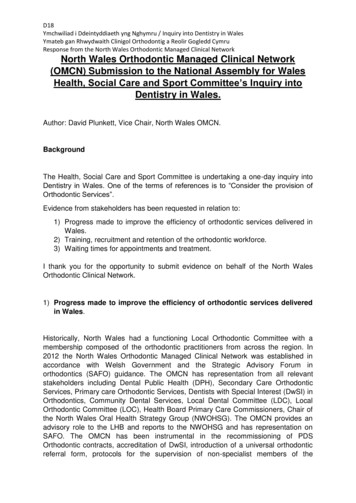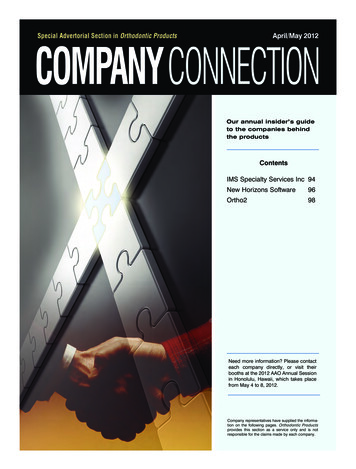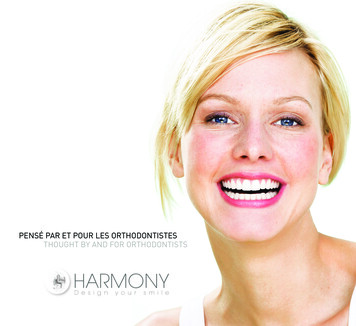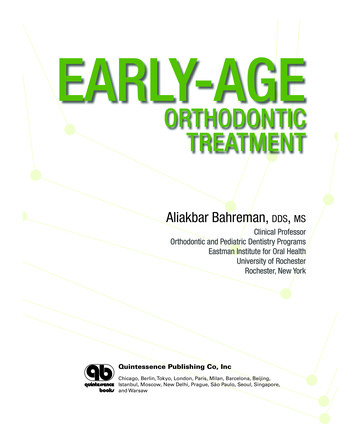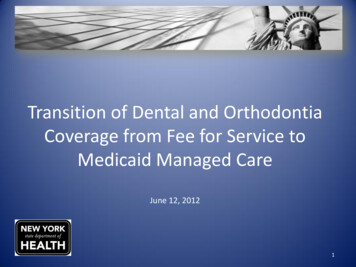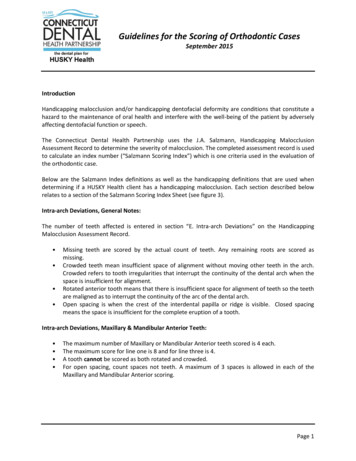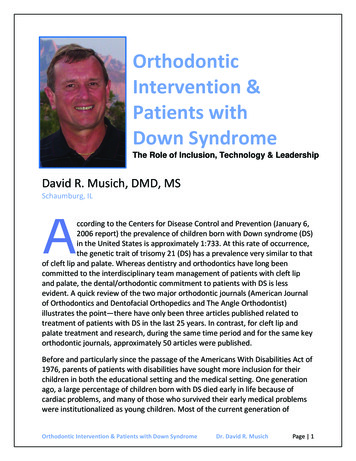
Transcription
OrthodonticIntervention &Patients withDown SyndromeThe Role of Inclusion, Technology & LeadershipDavid R. Musich, DMD, MSSchaumburg, ILAccording to the Centers for Disease Control and Prevention (January 6,2006 report) the prevalence of children born with Down syndrome (DS)in the United States is approximately 1:733. At this rate of occurrence,the genetic trait of trisomy 21 (DS) has a prevalence very similar to thatof cleft lip and palate. Whereas dentistry and orthodontics have long beencommitted to the interdisciplinary team management of patients with cleft lipand palate, the dental/orthodontic commitment to patients with DS is lessevident. A quick review of the two major orthodontic journals (American Journalof Orthodontics and Dentofacial Orthopedics and The Angle Orthodontist)illustrates the point—there have only been three articles published related totreatment of patients with DS in the last 25 years. In contrast, for cleft lip andpalate treatment and research, during the same time period and for the same keyorthodontic journals, approximately 50 articles were published.Before and particularly since the passage of the Americans With Disabilities Act of1976, parents of patients with disabilities have sought more inclusion for theirchildren in both the educational setting and the medical setting. One generationago, a large percentage of children born with DS died early in life because ofcardiac problems, and many of those who survived their early medical problemswere institutionalized as young children. Most of the current generation ofOrthodontic Intervention & Patients with Down SyndromeDr. David R. MusichPage 1
parents of children with DS make a significant effort to include their DS children inmany aspects of traditional family life, school, and sports. In addition, bettereducational mechanisms exist to assist them andtheir children medically and socially. Medical supportgroups and parent support groups have been veryactive in optimizing the quality of life for childrenwith DS. The combination of these changes over thepast few decades has led to a 100% increase in thelife expectancy of persons with DS (from a previousaverage life expectancy of 30–40 years to a currentlife expectancy of 60–70 years).There are many dental conditions common to children with DS that are wellsuited for orthodontic intervention and should be considered for correction at theappropriate times.1&21. Maxillary anteroposterior hypoplasia (54% of DSpatients have Angle Class III tendencies);2. Maxillary transverse hypoplasia (65% of DS patientshave posterior crossbites);3. Congenitally missing teeth (20 times more frequent inDS patients than in the general population);4. Tooth size discrepancy (high degree of frequency ofinterference with ideal interarch coordination);5. Open bite (interfering with proper mastication);6. Impacted teeth (10 times more canine impactions thanthe non-DS population);7. Transposed teeth (15% with Mx.C.P1 transpositions,compared to 0.3% in the general population);8. Tongue thrust and protrusive tongue posture (musclehypotonicity and joint laxity are frequently presentrequiring speech and myofunctional therapy);9. Gingival excess and periodontal infection;10. Chewing difficulties leading to frequent chokingepisodes.The above conditions benefit from timely orthodonticintervention; frequently, a two‐phase or multiphaseOrthodontic Intervention & Patients with Down SyndromeParents ofchildrenwith DSmake asignificanteffort toinclude theirDS childrenin manyaspects oftraditionalfamily life.Dr. David R. MusichPage 2
treatment program is beneficial to assist in early correction of maxillarytransverse deficiency and Class III malocclusion. In addition, if a child has morethan one of these frequently occurring conditions, advanced interdisciplinarytherapy will be required with a well‐coordinated and experienced dental team,including critical treatment planning input from the orthodontist.Technologic advances in orthodontics have made it possible for orthodontists tocreate a treatment environment that welcomes children with special needs andtreatment requirements. The following technologic improvements help allorthodontic patients, but some are specifically useful for patients with DS:1. Impressions using quick-set materials with fun flavors—these may reducethe tendency for activation of the more sensitive gag reflex frequentlyexperienced with DS patients;2. Easy bonding of brackets rather than more complex and uncomfortablebanding procedures;3. Self-etching primer, to reduce the taste of conventional etchants and glassionomer cements that can be used in the oral environment in which it isdifficult to maintain a dry field for several minutes at a time;4. High-memory wires, allowing a longer activation interval betweenappointments;5. Self-ligating brackets, which allow a more patient-friendly activationappointment;6. Advances in orthognathic surgical techniques that are less invasive andmore predictable;7. Current reliability of implant replacement of congenitally absent teeth, whichgreatly aids the overall prognosis for patients with DS;8. Reversible implant anchorage devices to minimize compliance requirementsneeded for successful tooth movement.SummaryThe orthodontic specialist has many treatment management tools and skills toimprove the quality of life for the patient born with DS. The use of the newSupplemental History form available through the American Association ofOrthodontists (AAO) allows the parents to provide helpful descriptions of detailsabout their child that will allow the dental team to create a health careenvironment that is more sensitive and comfortable for both the parent and theDS child.Orthodontic Intervention & Patients with Down SyndromeDr. David R. MusichPage 3
With the technological advances available and the increasing numbers of kidswith DS seeking orthodontic care, our orthodontic residency programs need toinclude training for orthodontic treatment of DS patients similar to the trainingavailable for cleft palate team participation. Currently, the AAO's Council onEducation is assessing the role of residency programs training futureorthodontists to handle the unique needs of patients with DS and patients withother special needs. Doctor and staff training with clinical updates would be madepossible at university centers. Through more frequent journal articles andpresentations on this subject, orthodontic specialists might become morecomfortable setting aside the extra time needed to manage the requirements ofchildren with DS.The orthodontic specialty is rapidly becoming aware of the need for its leadershipin developing an optimal interdisciplinary setting for providing patients with DSwith the advanced dental care available and needed to improve the quality oftheir lives. With many excellent residency programs in North America, one couldeasily envision orthodontic specialists taking the lead in the development ofinterdisciplinary DS treatment teams. In turn, those teams could contribute toexisting guidelines that would aid in future treatment approaches, which wouldbe specifically designed for the multifaceted dental problems of the DS patient.2Although the optimal treatment of DS patients presents complex challenges fororthodontic specialists and their teams, the fulfillment of applying the bestavailable orthodontic skills to help children with DS is uniquely rewarding.Providing the care and enjoying the fulfillment are experiences in which allorthodontists and staff must be adequately trained.References1. Pilcher ES. Dental care for the patient with Down Syndrome. Downs Syndr Res Pract. 1998; 5:111–116.2. Desai SS. Down Syndrome. A review of the literature. Oral Surg Oral Med Oral Pathol Oral Radiol Endod.1997; 84:279–285.3. 3. Cohen I. Health care guidelines for individuals with Down Syndrome. Down Syndr Q. June 1996; 1:2This article appeared in the The Angle Orthodontist: Vol. 76, No. 4, pp. 734–735.It is provided here with permission of the author Dr. David Musichto Berning & Affiliates, Inc. for use on the website.Orthodontic Intervention & Patients with Down SyndromeDr. David R. MusichPage 4
Other documents provided with this articleinclude:¾ Seminar Handout for Parents of DS Children,which includes a Supplemental PatientQuestionnaire¾ Copy of article “Treating Down SyndromePatients” which appeared in OrthodonticsProducts OnlineOrthodontic Intervention & Patients with Down SyndromeDr. David R. MusichPage 5
Orthodontic possibilities for children with Down SyndromePresented to Ups for Downs parent groupApril 22, 2010Drs. Musich and Busch“Form and function through art, science and teamwork.”
ContentsI.Common dental conditions and terminologyp. 3II.Helping to make the dental (ortho) office feelcomfortable and safe (supplemental questionnaire) p. 4Sample questionnaire completed by parent of Down patientIII.Orthodontic study records and their purposeIV.Orthodontic appliances useful to treat dentalconditions of kids Down SyndromeV.Considerations in the timing of treatment—Multiphase treatment and its advantagesPhase I parent information sheetsp. 5p. 6p. 7-8VI.Information regarding impacted caninesVII.Frequently asked questions by parents and kids p. 11VIII. Summaryp. 9-10p. 122
Common dental conditions and terminology associated with DownSyndrome:¾ 20x--Missing teeth¾ 10x-Impacted teethShort roots frequentIMIMMM15%Transposition teethMMM¾ Ectopic teeth (transposed positionwith another tooth) M¾ Retained baby teethEE¾ Crossbite (Anterior/underbite and posterior) 65% have post. XB54% w Ant. Xbite¾ Oversized tongue9 Jaw growth imbalanceMore than 1/2 Class III withunder bite of anterior teeth3
II. Helping to make the dental/ortho office feel comfortable and safe(supplemental questionnaire)Patient’s Name:Date:On your health history you have identified your child withWould you please help us understand more about this condition and how it might affect your child in a dental /orthodontic setting?1. Could you tell us about the condition your child has and how it affects his/her behavior.2. Please describe any significant fears or anxieties that your child may experience during visits to health careprofessionals (including dental).3. Has the anxiety or fear prevented any necessary treatment? Please describe.4. Are there any strategies that help your child open up to new experiences such as a visit to a new doctor(Examples: show and tell, humor, going very slowly; modeling with parent or other sibling, other examples)?5. Are there physical disabilities that need to be taken into consideration? (Examples: Difficulty with fine motor skills)6. Are there learning disabilities that need to be taken into consideration?(Examples: Auditory processing difficulties, sensory integration dysfunction, or speech and language difficulties)7. Any additional information that might help us to provide a positive office experience for your child?
4III.Orthodontic study records: Study models Panoramic x-ray Lateral Cephalometric analysis Postero-anterior head x-ray Photographs Wrist x-rays to assess phys. Maturityand to aid in proper timing of treatment
IV.Orthodontic Appliances useful to treatdental conditions of kids with Down Syndrome5¾ Expanders to widen palate¾ Partial Braces to align incisors¾ Removable traction applianceTo provide elastic traction toAccelerate forward growth of upper jaw¾ Removable retainersWith replacement tooth¾ Fixed retainersBefore braces
6VI. Frequently asked questions by parents and kids:¾ Will braces or the expander hurt?¾ What do you mean by orthodontic records?¾ How do the orthodontic appliances affect speech?¾ My child has a lot of anxiety—what can be done?¾ What will my child be able to eat with braces on?¾ Will my child have more cavities while in braces?¾ Most of my child’s teeth are baby teeth—aren’t they too young forbraces?¾ Has any new technology helped to reduce the “hassle factor” relatedto braces?Your specific questions:Thank you for your interest.
More Smile for Patients with Disabilities11Orthodontists open doors to accommodate patients with special needsFrom the Bulletin of the American Association of OrthodonticsJan/Feb, 2004“I do believe that Angie taught everyone on the team a few very important things along theroad. A person with a disability is still just a person who deserves to be treated with dignityand respect. Never assume someone doesn’t understand what you’re saying because they don’tspeak as well as you. If you have the patience to really listen to what they have to say, you willrealize that they have likes and dislikes, friends and interests, hopes and dreams just like therest of us. If you give them a chance, you will be amazed at some of the gifts they have toshare and how they can bring you so much joy.”Angela’s mom, Mrs. PicchiOrthodontic specialists who treat pts. w DS:Drs. Musich and Busch—847-517-1333Schaumburg, ILDr. Pat Foley—847-438-8899Lake Zurich, ILDr. Jim Kohl—847-251-3323Wilmette, ILDr. Kevin Lucas—847-955-9444Buffalo Grove, ILDr. Mike Klepacki—630-325-0100Hinsdale, ILDr. Scott Prose—630-584-6555St. Charles, ILDr. Mike Naborowski—630-543-5051Addison, ILDr. Deanne Schmidt—847-854-1873Algonquin, ILPediatric dentists available for DS patients:Drs. Hill-Cordell/Broderson—847-8823360Schaumburg, ILDr. Mike Ewers—Elmhurst, ILDr. Denise Fisher—847-882-2555Hoffman Estates, ILDrs. McElroy/Campbell—630-351-4440Bloomingdale, ILDrs. Morton and Shore—847-885-1095Hoffman Estates, ILDr. Erwin Seidman—847-991-4663Palatine, ILDr. Vicky Ursitti—847-870-0475Arlington Hts., IL
ChairsideWith David R. Musich, DDS, MSTreating Down Syndrome PatientsOP: Do you interact with Down syndrome (DS) patients differently thanwith your other patients?Musich: When parents fill out the child’shealth history and indicate that theirchild has a special need, we ask the parentto fill out the AAO’s Supplemental HealthHistory form for children with specialneeds (developed by the AAO’s Councilon Orthodontic Practice). This providesus with very important insights from thepatient’s parents regarding key factorsthat need to be taken into considerationwhen treating their child. It should bementioned that we do not treat ourpatients with DS with any treatmentplanning bias. We start with the thoughtof achieving an ideal outcome. Like withother children, if we find that we are notgetting a reasonable response, then wemight reset our objectives after discussingthis with the parents and child.OP: Have you had training sessions foryour staff in how to treat DS patients?Musich: This is a very important question. Yes, we have the good fortune tohave one clinical staff member (JolettePorter) who has a background in earlychild development and who worked withchildren with autism after college. Joletteand Matthew J. Busch, DDS, (my partner, who is excellent in the managementof special-needs children) have had periodic training programs with clinical staffto help them develop skills to manageand customize the treatment situation(private room, longer appointments, etc)so that we are able to achieve the bestresults possible. Most of the clinical stafffollow the lead of the doctors. We arevery positive in our approach to treatment and to treatment planning.Orthodontic assistants who have notworked with children with special needsdo require several observation appointments to gain their own self-confidencein working in the smaller oral cavity.OP: What's the biggest challenge indealing with these patients?12 OrthodonticProductsOnline.com October 2006Musich: Overcoming “iatrogenic negative conditioning” that parents mayhave due to faulty information aboutkids with DS and orthodontics.Establishing an office setting diminishes the anxieties and fears that kidswith DS may feel more than other children of similar age. (Does wearing adental mask upset them? Does the dental light bother their eyes? Does thesound of the high-speed handpiece orsuction bother them? What about theirgag reflex?) By learning about their sensitivities, we can take steps to desensitize them and create good experiences.Two things that we have done to consistently create good experiences are:1) Establish appointment patterns sothat each appointment is a similarexperience—same chair, same privateroom, etc.2) Incorporate a customized patientmanager system in which two assistantsare assigned to the patient and will seehim or her at each visit to stay familiarwith established patterns.With the incorporation of some ofthe above strategies, we frequently seethe older DS kids show newfound independence, come to the chair on theirown, and seem very proud of theircomfort and maturity.OP: What advice do you have for orthodontists who are considering treatingDS patients?Musich: Recently (July 2006) I published aguest editorial in the Angle Orthodontistthat was motivated by the feedback wehave received from parents of DS patients.1The point of the editorial was to point outhow important leadership from membersof the orthodontic specialty has become inthe area of orthodontic treatment for kidswith DS. All children with DS have significant orthodontic needs. Thus far, there islimited training in the graduate programsto help residents understand what theirrole might be in the management of malocclusions of children with DS. My adviceto orthodontists considering treating kidswith DS:1) Use thesupplementalhealth history questionnaire developed by theAAO—it is very helpful.42) Read the quote from Mrs Picchi—parent of Angie, who was treated about8 years ago. Read the articles listed asreferences below.1–63) Spend some time discussing theappropriate management of dental anxiety with your staff. This is the main issuethat seems to be common in kids withDS. Find out if any staff are interested intaking the lead with the orthodontist indoing specific research to understandadditional complexities in the behavioralmanagement of anxiety. Working withlocal pediatric dentists can be very helpful to learn some of the behavioral techniques they use with their DS patients.4) Go slowly. Explain everything. Usethe “show and tell” technique. Developthe child’s trust through showingrespect for his or her comfort level withthe procedures.5) Realize that you are not going to setany speed records in the treatmentprogress, but in general you can expectvery good results, with occasional limited outcomes.6) When the confidence levelimproves, offer to give a presentationto the local chapter of the NationalAssociation for Down Syndromeabout the Orthodontic Possibilitiesfor Kids with Down Syndrome. zDavid R. Musich, DDS, MS, is the current president of the E.H. Angle Society ofOrthodontics and is a professor of clinicalorthodontics at the University ofPennsylvania and the University ofIllinois, Chicago. He can be reached atdrm4drmltd@aol.com.For references, answers to more questions, Mrs. Picchi’s quote, and a sample questionnaire for patients with special needs, see the online version atOrthodonticProductsOnline.com.
Common dental conditions and terminology associated with Down Syndrome: ¾ 20x--Missing teeth ¾ 10x-Impacted teeth Short roots frequent 15%Transposition teeth ¾ Ectopic teeth (transposed position with another tooth) ¾ Retained baby teeth ¾ Crossbite (Anterior/underbite and posterior) 65% have post.XB 54% w Ant. Xbite ¾ Oversized tongue 9 Jaw growth imbalance




